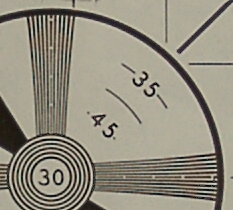
[last update 25 June 2000]
I have done some auto focus tests using a tripod and the self-timer mode to prevent camera shake - I was not sure if auto focus is really good enough for a camera of this resolution - and it is very difficult to see the focus in the LCD. Experience with high definition television cameras is that it is difficult to see focus even in a full -resolution viewfinder. Some HDTV cameras have a focus-aiding circuit that causes fine detail to twinkle in the viewfinder.
It turns out that the autofocus appears to be accurate, to the point that you can see the resolution limits imposed by the RGB optical filters and the interpolation that must be done for a single-CCD camera.

The image shows a small portion of a test pattern. The camera was zoomed back so that the pattern size was 925x687
pixels (the aim was to have approximately half the dimensions of the CCD). With this pattern, the resolution numbers
are in TV lines per picture height. ("35" on the chart means 350 TV lines per picture height, etc.) With
a 3-CCD camera, in which each pixel is sensed in all three primary colors, the resolution should go to about 85%
of the number of pixels per height with usable response (depending on optics) and little or no aliasing. The single
CCD camera will need some optical integration (provided by the lens or a deliberate optical low pass filter) to
prevent color aliasing, and in addition will use an interpolation process to form red green and blue values for
all pixels.
Here's a link to a research paper on the interpolation process:
If you zoom in on the part of the resolution wedges near the central circle, you can see that the the contrast is reduced and there is a slight "rainbow" of color aliasing. This is a quite acceptable compromise performance for a single-CCD camera.
The resolution expected from a 3-CCD camera would be 687x.0.85 = 583 (beyond what can be read on the chart). This camera achieves roughly 475 = 687 x 0.69 (it is hard to assign a limiting value, since the response tails off gradually).
The manual focus is not as convenient as I would like - particularly in that the adjustment arrows time out quickly which requires you to request manual focus again if you pause before you are done. Also, it is hard to tell if you are overshooting the correct adjustment. It would be better if the adjustment mode persisted until you take the picture or actively turn it off. Also, of course, it is difficult to see the optimum focus point in the LCD display. A numerical indication of focus distance might be a help.